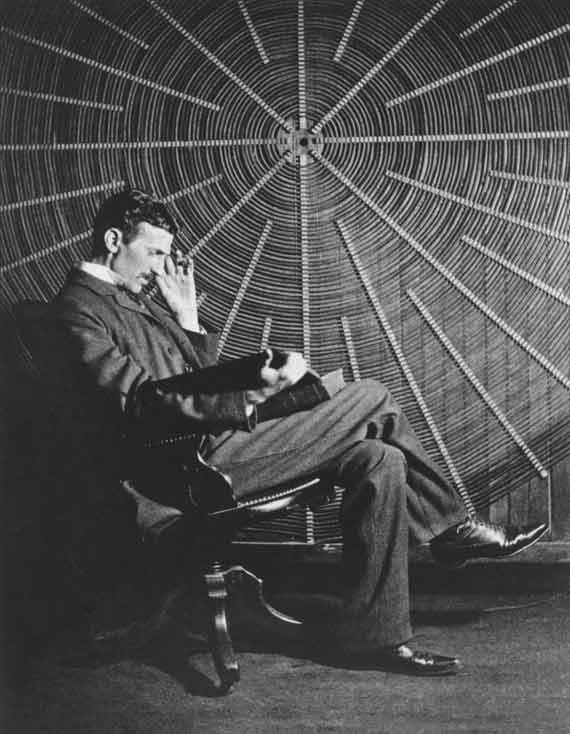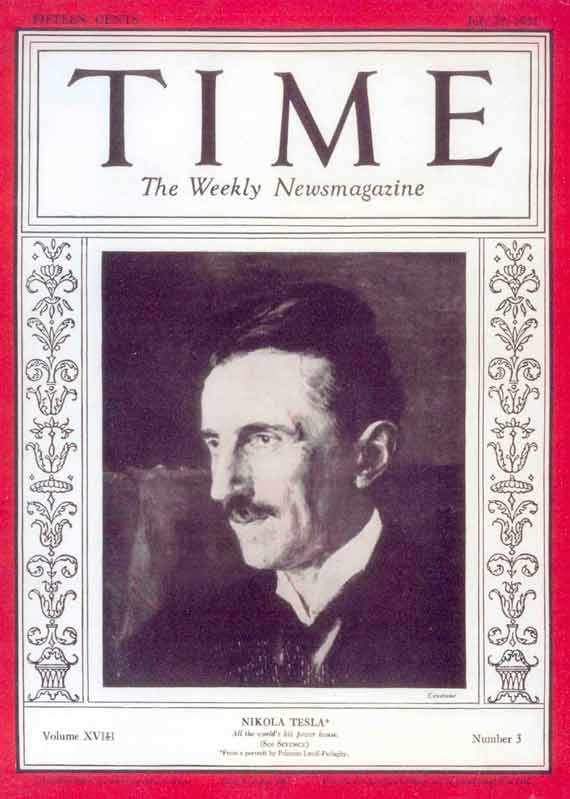The figure of the mad scientist, the eccentric genius, no longer belongs exclusively to Einstein. In the last two decades, the public fascination with the figure of Nikola Tesla has enlarged the myth to such an extent that it now exceeds the unquestionable achievements of this great Serbian inventor. In popular culture, Tesla is seen as an unsung hero whose merits were not sufficiently recognized. And in this mythical story appears a greedy villain named Thomas Edison, who first does his best to prevent Tesla’s success and later tries to smother his recognition

However, the documented reality is different. The achievements of Nikola Tesla (1856-1943) were immediately recognized and he was a revered figure from a young age until his final years, both by his peers and by the general public. Already in 1896, the grand Knight of physics, Lord Kelvin, said that, “Tesla has contributed more to electrical science than any man up to his time.” And the truth is that the most important award that Tesla received was the Edison Medal, which his supposed enemy could easily have prevented, because this distinction was created and awarded by a commitee which included some good friends of Edison.
On May 18, 1917, the American Institute of Electrical Engineers (now the IEEE) awarded Tesla with the Edison Medal. That day marked exactly 29 years since the publication (on May 18, 1888) of a scientific article in which Tesla detailed his greatest success as inventor: an induction motor operating with a polyphase system working on alternating current.

On May 1, 1888 Tesla had already been awarded with several patents related to the induction motor and polyphase system — and, since Edison had rejected his proposals, he had put them to the service of Westinghouse Electrics. With the alternating-current technology under its control, Westinghouse won the “War of Currents” against Edison and General Electrics, who had bet on direct current. It was a tough technical, commercial and legal battle in which Edison played with the public’s fear of electric shocks, even going so far as to electrocute animals in public to demonstrate the dangers of alternating current. In that times Edison dismissed Tesla as “a poet of science. His ideas are magnificent, but utterly impractical.”
Tesla’s great homage
However, by 1917 the hatchet had been buried. The Edison Medal recognized the great idea of Tesla, whose technology had been used not only to illuminate the cities but as the “almost universal means to transform electrical energy into mechanical energy.” In his speech the night he received the medal, Bernard A. Behrend added, “were we to seize and to eliminate from our industrial world the results of Mr. Tesla’s work, the wheels of industry would cease to turn, our electric cars and trains would stop, our towns would be left in the dark, our mills would be dead and idle.”
Nikola Tesla expressed his thanks for the award and dedicated these words to Edison, praising his practical views: “When I came to America, I met Edison, and the effect that Edison produced upon me was rather extraordinary. I saw how this extraordinary man, who had had no training at all, did it all on his own. I felt mortified that I had squandered my life — you see I had studied a dozen languages and had delved in literature, reading anything that fell into my hands.” Tesla remembered his first year in the US when worked tirelessly for Edison, and Edison admired Tesla’s stamina.
However Tesla emphasized in his speech that tenacity and hard work were the only things that he shared with Edison: “I did not need any models nor drawings or experiments, I could do it all in my mind. The way I unconsciously developed a new method for materializing inventions and ideas, is exactly the opposite of the purely experimental method, of which undoubtedly Edison is the greatest and most successful exponent.” That speech of 1917 reveals nothing more than a professional distance between Edison and Tesla.
From praise to criticism
Years and decades passed until Edison died in 1931. The following day The New York Times published these statements by Tesla: “If he had a needle to find in a haystack, instead of stopping to think where it was most likely to be, he would proceed with the feverish diligence of a bee, to examine straw after straw until he found the object of his search. His method was inefficient in the extreme […] I was almost a sorry witness of such doings, knowing that a little theory and calculation would have saved him ninety per cent of his labor.”
“In view of this, his accomplishments are almost a miracle. The recurrence of a phenomenon like Edison is not very likely. He will occupy a unique and exalted position in the history of his country, which might well be proud of his great genius and undying achievements in the interest of humanity,” added Tesla, who also highlighted Edison’s lack of hobbies and scant appreciation for the personal hygiene.

Those criticisms to science icons were not uncommon to Tesla, who kept on receiving praises. In the year of Edison’s death, Nikola Tesla was 75 years old and Time magazine dedicated its entire front page of the July 20, 1931 edition to him, with the caption “All the world is his power house.” Albert Einstein himself congratulated Tesla on his 75th birthday: “As an eminent pioneer in the realm of high frequency currents… I congratulate you on the great successes of your life’s work.”
On his side, Tesla never accepted quantum physics or the theory of relativity: “Einstein’s relativity work is a magnificent mathematical garb which fascinates, dazzles and makes people blind to the underlying errors. The theory is like a beggar clothed in purple, whom ignorant people take for a king… its exponents are brilliant men but they are metaphysicists rather than scientists,” he declared in 1935 to The New York Times. Tesla rejected the wave-particle duality of space curvature and said to the press that he could make electricity travel faster than light.
Tesla spent his last years investigating a weapon to achieve world peace, which he called the “death ray”. The elegant and lanky Serb who had dazzled New York society in the late nineteenth century was now an eccentric old man, with scarce economic resources, who lived alone in a hotel room and went out of his way to feed and care for the pigeons on the streets of the Big Apple.
It was in this state that Tesla died in 1943 at the age of 86. The following year a journalist very close to Tesla in his final years, John J. O’Neill, published the first biography of the great inventor: “Prodigal Genius: The Life of Nikola Tesla.” It was this book that began to forge the role of Edison as the villain, recalling a disagreement when Tesla was still working for him, many years earlier. Tesla told O’Neill that Edison promised him $50,000 if he could redesign some machines which he had in his business which were extremely inefficient. Tesla claimed that when he succeeded, Edison refused to pay him and instead mocked him.
For historians such as Jill Jones, author of “Empires of Light”, it is not credible that Edison would offer a novice worker such a large sum, which would be equal to the initial capital of the company and to 53 years of young Tesla’s salary. Whether this was the reason, or that his supervisor did not want to raise his salary from $18 to $25 a week (as noted by other sources), the fact is that Tesla quit his job after less than a year in the company and set up his own enterprise in 1885 to bet on alternating current.
A more “novelized” version
Tesla never forgot that disagreement, acording to his first biographer. In the chapter on the Edison Medal, O’Neill portrays a Nikola Tesla who at first wanted to reject the prize and then disappeared from the gala held in his honor at the key moment. He had gone to feed the pigeons. His friend Behrend found him in the street «wearing a crown of two pigeons on his head, his shoulders and arms festooned with a dozen more. On either of his outstretched hands was another bird, while seemingly hundreds more made a living carpet on the ground.»
According to the details of this story, the inventor made a gesture so that some of the birds flew from Tesla’s shoulders to his astonished friend. And then Tesla went back to the gala and gave a long and improvised acceptance speech, of which no records were kept. Thus, Tesla’s first biography excluded this episode in which he publicly praised Edison. But the speech is however quite well preserved (you can find it here, almost intact) and was published a week later by the magazine Electrical Review and Western Electrician.
With this air of mystery and eccentricity, but without documentary rigor, the book “Prodigal Genius: The Life of Nikola Tesla” spread the idea of an exacerbated antagonism between Edison and Tesla, and it began to permeate popular culture as other biographers repeated John J. O’Neill’s version, including the scene with the pigeons. Tesla’s story may be more fascinating that way, with an evil Edison in the shadows. However, as was evident at the 1917 tribute and in many other recognitions later on, a villain was not needed in order to enhance the exploits of the great hero of electricity.
Comments on this publication